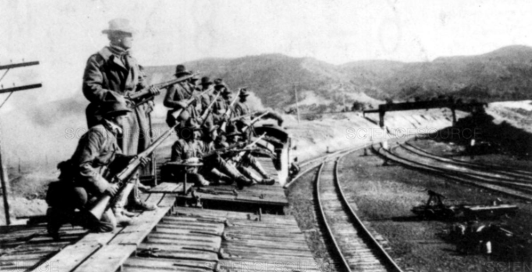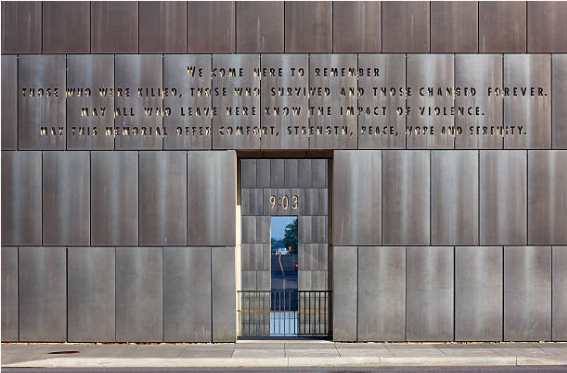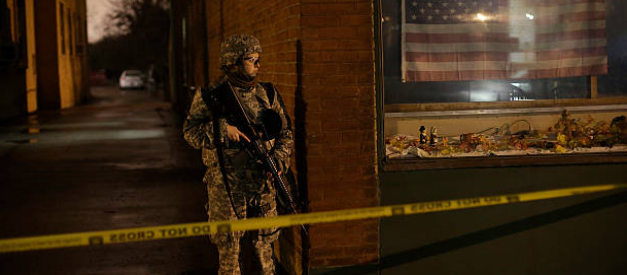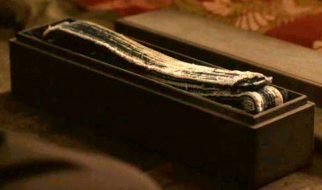Three Scenarios, One Lesson For America?s Next Breakdown
 US soldier stands guard outside Ferguson City Hall during demonstrations in 2014. Courtesy: Joshua Lott/Getty Images.
US soldier stands guard outside Ferguson City Hall during demonstrations in 2014. Courtesy: Joshua Lott/Getty Images.
There?s been a lot of talk about the divided state of the nation lately. Rifts over politics are nothing new, but it has become a trend to talk of the ultimate worst-case scenario ? civil war.
As recently as December 2019, The Atlantic published a series of articles in a special issue entitled, ?How To Stop A Civil War.? This follows the release of a poll conducted by Georgetown University, which showed many American voters believed the country was ?2/3rds away from the edge? of such a crisis.
I, for one, am not so pessimistic about the nation?s future. The United States has suffered many setbacks in the past, including the loss of naval power, total economic collapse, and the outright disintegration of the Republic itself, and it still managed to recover. Nevertheless, with a campaign staffer for presidential candidate Bernie Sanders saying ?cities will burn? in the event of President Donald Trump?s re-election, along with revelations of three Neo-Nazis plotting to use Virginia?s gun rallies to initiate a ?civil war,? it is only necessary ? if not vital ? to re-examine a few scenarios that might occur in the event of such a catastrophe.
There haven?t been many cases of conventional forces facing off against each other since America?s first Civil War, so said conflict will likely take the form of something non-conventional. It took some time to narrow down these scenarios, but all three are plausible for a simple reason.
They actually happened.
Scenario 1 ? The Coal Wars
 Colorado National Guard on the eve of the Ludlow Massacre, 1914. Courtesy: New York Public Library/Science Source.
Colorado National Guard on the eve of the Ludlow Massacre, 1914. Courtesy: New York Public Library/Science Source.
Coal has always been a staple to America?s economy, but the boom of the late 1800s brought forth the chaos that comes with reliance on a natural resource.
By the early 1900s, the Midwest and Appalachia became battlegrounds between the United Mine Workers of America and coal barons. These conflicts reached a boiling point in Ludlow, Colorado. From September 1913 to December 1914, striking miners erected tent cities and refused to disperse unless demands were met by the Colorado Fuel & Iron Company. Said demands included child labor laws, 8-hour works days, and the right to assemble.
As tensions between strikers and authorities escalated, Colorado governor Elias M. Ammons summoned the National Guard to handle the strike. The occasional skirmish yielded no results, and Governor Ammons was forced to withdraw all but two companies of the Guard after the state ran short of funds to fuel the operation.
The strikers held out until April 20th, 1914, when the remaining guardsmen opened fire with machine guns. A day-long battle ensued, which ended in the camp burning to the ground. Approximately 20 strikers and 3 militia lost their lives. Ten days of subsequent violence would prompt President Woodrow Wilson to federalize the National Guard and order them to disarm both sides of the conflict.
World War One brought a short end to hostilities, but the post-Armistice years saw a resurgence in violence between coal miners and strike-breakers ? this time, in West Virginia.
By 1921, the ?Mountain State? had become the Heart of Darkness for the Coal Wars. The preceding years saw a series of bombings and shootouts which resulted in martial law being declared at least three times. Following the assassination of a police chief who sympathized with Logan County strikers, 10,000 coal miners took up arms and marched toward Mingo County to confront the coal barons. A force of 3,000 police and citizens? militia would meet them at a place called Blair Mountain.
Starting on August 25th, both sides traded machine-gun fire and frontal assaults against each other?s positions. The apex of these engagements occurred when private biplanes flew overhead to drop homemade explosives and gas bombs on the miners. By the time President Warren G. Harding dispatched the National Guard to end the hostilities, nearly 100 miners, 30 authorities, and 3 National Guardsmen were dead. The leaders of the movement would be tried and convicted of treason, but a majority would be acquitted and pardoned in the following years.
The Coal Wars ultimately led to better laws for workers across the United States, but the ?largest uprising since the Civil War? would be overshadowed in history books for years to come.
Scenario 2? The 1960s & 1970s
 The National Guard passes a burning store in Washington DC, 1968. Courtesy: UPI staff photographer Darryl Heikes/GettyImages.
The National Guard passes a burning store in Washington DC, 1968. Courtesy: UPI staff photographer Darryl Heikes/GettyImages.
One needs to look no further than the late 1960s to see American cities aflame, National Guardsmen patrolling the streets, and ordinary citizens seeking refuge in Canada.
Three years into America?s conflict in Vietnam, Reverend Martin Luther King Jr. was cut down by an assassin?s bullet in Memphis, Tennessee. Within 24 hours, nearly 100 cities across the United States were devastated by riots. The fires in many of these cities raged until the National Guard arrived on the streets to restore order. Among these cities was Wilmington, Delaware, which saw the longest military occupation of an American city since the Civil War.
By 1969, the epidemic of riots and arson culminated in the Days of Rage, where rioters and police clashed throughout Chicago. Coinciding with these riots was a string of bombings in major metropolitan areas. The culprits, dubbing themselves the Weathermen, would initiate a terror campaign against the federal government that would drag into the 1980s. Said targets of their ?revolution? included the Pentagon, the State Department, and even the nation?s Capitol. Other groups, such as the Black Liberation Army and the Symbionese Liberation Army, would receive national attention in the form of shootouts against federal agents. In all, the period between 1971?1973 saw approximately 2,500 domestic bombings from leftist organizations trying to ?bring the war home.?
As America?s cities burned, the rural Midwest saw its share of violence with factions, such as the American Indian Movement, clashing with riot police in towns like Custer City, South Dakota. Years of mistreatment and abuse of Native Americans resulted in standoffs at Alcatraz, Mount Rushmore, and Wounded Knee. The war in Vietnam had indeed come home, and all Americans felt the pains of a nation in crisis.
As the war wound down, the left-wing resistance gradually lost the support it needed to implement a class war. Drugs and fuel prices gradually took their toll. Counterculture figures such as Abbie Hoffman would succumb to despair while others, such as Weathermen leaders Bill Ayers and Bernadine Dorhn, would turn themselves in after a decade on the run.
The last embers of the 1960s fizzled out with the arrest of militant Marxist Ray Levasseur, who in 1984 described his fugitive experience as the ?radical equivalent of the aging Japanese infantrymen found in Pacific caves well into the 1970s, men still fighting a war everyone else knew only from history books.?
Scenario 3? The Patriot Movement
 A Chinook helicopter flies over the burning Branch Davidian compound near Waco, TX, 1993. Courtesy: Tim Roberts/AFP via Getty Images.
A Chinook helicopter flies over the burning Branch Davidian compound near Waco, TX, 1993. Courtesy: Tim Roberts/AFP via Getty Images.
Following the election of Democrat President Bill Clinton in 1993, the nation saw the emergence of a right-wing militia movement that included civil libertarians, Christian fundamentalists, and white nationalists.
The US had consolidated its position as the sole superpower after the Cold War, but many Americans became galvanized by events such as the Rodney King riots, the passing of NAFTA, and a series of botched arms raids by federal agents. Tensions further escalated with the passing of the Brady Act in 1993, which required a five-day waiting period and background checks to obtain a firearm.
In response to this government ?conspiracy? to disarm and subdue the nation, unorganized ?Patriot? groups sprouted in states like Michigan, Illinois, Connecticut, and Florida. While mostly non-violent, the assassination of a police officer in Opelika, Alabama in 1993 became the first sign of trouble with this new wave of anti-government resistance.
The movement took a darker shade following the arrest of five members of a Virginia hunt club when authorities discovered a plot to attack a National Guard armory. It was not until the bombing of the Alfred P. Murrah Building in 1995 ? which killed 168, including 19 children ? that the movement achieved notoriety. The culprit, Timothy McVeigh, proved to be a lone wolf with his own agenda, but his actions showcased the anti-government fury resonating throughout the country.
Federal raids in Georgia, West Virginia, and Texas would also turn up bomb plots against federal targets, including Fort Hood. Elsewhere, federal agents faced stiff resistance in a six-day standoff against Texas ?separatists? and an 81-day standoff against the Freemen of Montana.
The body count of this movement would be relatively low, but as an FBI-infiltrator of the Montana Freemen chillingly revealed in False Prophets: The Firsthand Account of a Husband-Wife Team Working for the FBI and Living in Deepest Cover With The Montana Freemen (pg. 268):
I was able to learn the code words that would launch the nationwide attacks: Project Worst Nightmare. It was an appropriate name for what the militias had planned.
In the blink of an eye, with the stroke of a few computer keys, the ?go? order could be simultaneously sent to dozens, scores, or even hundreds of computers in towns and cities across the land. Then armed and trained men in small groups would simply walk out of their homes, offices, factories, fields, and bars and proceed to create chaos on a scale never seen in this country, or anywhere else in the civilized world?It would be Oklahoma City all over again, only multiplied dozens of times.
Federal pressure on the movement took its toll, and by the year 2000, the movement saw a decline of 20%. As with its left-wing predecessors from the 1960s, the Patriot movement?s decline was attributed to age, lack of interest, and overall disillusionment with a revolution that would never happen.
Lessons Learned (If Any)
 Entrance to Oklahoma City Bombing Memorial. Courtesy: Jeremy Woodhouse via GettyImages.
Entrance to Oklahoma City Bombing Memorial. Courtesy: Jeremy Woodhouse via GettyImages.
I understand if there are many details excluded from these scenarios. All must be examined in their own respective contexts, and I tried to summarize each as briefly as possible.
There are many lessons to be learned from these episodes, but if there?s a single takeaway, it?s the fact that they?ve largely become buried in history books. As tabloid journalists and McExperts recycle the topic of a ?Second American Civil War,? it becomes increasingly clear that the lessons of the Coal Wars, the turbulent 60s, and the Patriot movement have either been forgotten or outright ignored.
In this respect, the ?Second American Civil War? may come and go without anybody noticing. The death toll may be nowhere near as catastrophic as those in Syria or Afghanistan, but those who personally lose loved ones will easily beg to differ.
In this regard, I leave anyone pondering the notion of a new ?civil war? to further ponder the words of Bosnian Civil War survivor, Selco Begovic, in his highly recommended work Dark Secrets of SHTF (Shit Hits The Fan) Survival (pg. 305):
What happened to many people I know who went through a hard time during the war?
Some of them are heavy drinkers, some of them are drug addicts, some are social ?weirdos? unable to have a friend, unable to have a normal relationship. Some are normal on the outside but also have a very dark or dead side.
Some of them continue to live as they lived during SHTF, with violence, so violence became their job. It was like somebody drew a line in time and said: ?OK before this moment a lot of things were acceptable because SHTF, but from this moment we all need to behave like nice folks, no more killing, stealing??
Some guys did not want to accept that, some could not, some killed themselves, some continued to kill others.
Once you have hit another human in the face, it is much easier to do that again.


